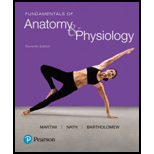
Fundamentals of Anatomy & Physiology (11th Edition)
11th Edition
ISBN: 9780134396026
Author: Frederic H. Martini, Judi L. Nath, Edwin F. Bartholomew
Publisher: PEARSON
expand_more
expand_more
format_list_bulleted
Concept explainers
Textbook Question
Chapter 1, Problem 14CP
Name the book that serves as the international standard for anatomical terms.
Expert Solution & Answer
Want to see the full answer?
Check out a sample textbook solution
Students have asked these similar questions
What is the Importance of Anatomical Terminology?
What is the best way to write anatomy regions?
Provide a labelled picture which demonstrates the six cardinal planes in human anatomy.
Chapter 1 Solutions
Fundamentals of Anatomy & Physiology (11th Edition)
Ch. 1 - Describe a learning outcome.Ch. 1 - Explain how to use your textbook most effectively...Ch. 1 - Define anatomy.Ch. 1 - Define physiology.Ch. 1 - Describe how anatomy and physiology are closely...Ch. 1 - What is the difference between gross anatomy and...Ch. 1 - Identify several specialties of physiology.Ch. 1 - Why is it difficult to separate anatomy from...Ch. 1 - Identify the major levels of organization of the...Ch. 1 - Identify the organ systems of the body and cite...
Ch. 1 - At which level of organization does a histologist...Ch. 1 - Prob. 12CPCh. 1 - Define eponym.Ch. 1 - Name the book that serves as the international...Ch. 1 - What is the purpose of anatomical terms?Ch. 1 - For a body in the anatomical position, describe an...Ch. 1 - Name two essential functions of the body cavities...Ch. 1 - Describe the various body cavities of the trunk.Ch. 1 - Define homeostasis.Ch. 1 - Which general mechanism of homeostatic regulation...Ch. 1 - Why is homeostatic regulation important to an...Ch. 1 - Prob. 22CPCh. 1 - What happens to the body when homeostasis breaks...Ch. 1 - Prob. 24CPCh. 1 - Prob. 25CPCh. 1 - Define equilibrium.Ch. 1 - When the body continuously adapts by using...Ch. 1 - LEVEL 1 Reviewing Facts and Terms 1. Label the...Ch. 1 - 2. cytology (a) study of tissues 3. physiology (b)...Ch. 1 - 2. cytology (a) study of tissues 3. physiology (b)...Ch. 1 - 2. cytology (a) study of tissues 3. physiology (b)...Ch. 1 - 2. cytology (a) study of tissues 3. physiology (b)...Ch. 1 - 2. cytology (a) study of tissues 3. physiology (b)...Ch. 1 - 2. cytology (a) study of tissues 3. physiology (b)...Ch. 1 - 2. cytology (a) study of tissues 3. physiology (b)...Ch. 1 - 2. cytology (a) study of tissues 3. physiology (b)...Ch. 1 - 2. cytology (a) study of tissues 3. physiology (b)...Ch. 1 - 2. cytology (a) study of tissues 3. physiology (b)...Ch. 1 - 2. cytology (a) study of tissues 3. physiology (b)...Ch. 1 - 2. cytology (a) study of tissues 3. physiology (b)...Ch. 1 - 2. cytology (a) study of tissues 3. physiology (b)...Ch. 1 - 2. cytology (a) study of tissues 3. physiology (b)...Ch. 1 - 2. cytology (a) study of tissues 3. physiology (b)...Ch. 1 - Prob. 17RQCh. 1 - The study of the structure of tissues is called...Ch. 1 - The increasingly forceful labor contractions...Ch. 1 - Prob. 20RQCh. 1 - A plane through the body that passes perpendicular...Ch. 1 - Prob. 22RQCh. 1 - Prob. 23RQCh. 1 - A learning outcome is best described as (a) a goal...Ch. 1 - (a) Define anatomy. (b) Define physiology.Ch. 1 - The two major body cavities of the trunk are the...Ch. 1 - What distinguishes autoregulation from extrinsic...Ch. 1 - Describe the anatomical position.Ch. 1 - Which sectional plane could divide the body so...Ch. 1 - Prob. 30RQCh. 1 - Prob. 31RQCh. 1 - Prob. 32RQCh. 1 - Besides the liver and most of the large intestine,...Ch. 1 - If the deep knife wound had been superior to the...
Knowledge Booster
Learn more about
Need a deep-dive on the concept behind this application? Look no further. Learn more about this topic, biology and related others by exploring similar questions and additional content below.Similar questions
- Discuss directional terms, anatomical position planes and sections used in anatomy.arrow_forwardcan you add words to describe each steps and what has been done pleasearrow_forwardGive an in depth summary of why it is important to know about anatomical guides and limits. Describe in detail about what and why it is fascinating to learn about it.arrow_forward
- Explain anatomical position and the reason we use it. Use anatomical termsarrow_forwardWhy is it important for persons working within the medical field to learn the proper anatomical and physiological terms? How would a person who has not learned these terms be at a disadvantage in their careers?arrow_forwardPlace levels of anatomical organization in the correct order from lowest to highestarrow_forward
- Identify all the cavities for each organ as follows: abdominal (A), cranial (C), pelvic (P), pericardial (PC), pleural (PL), peritoneal (PT), thoracic (T), and vertebral (V). 1. brain 7. spinal cord 2. small intestine 8. liver 3. heart 9. kidneys 4. lungs 10. uterus 5. bronchi 11. urinary bladder 6. stomach 12. ovariesarrow_forwardUsing images and correct anatomical terminology explain the location of the following organs of the human body (brain, heart, lungs, stomach, liver, bowel)arrow_forwardWhy is it fascinating to learn about anatomical guides and limits?arrow_forward
arrow_back_ios
SEE MORE QUESTIONS
arrow_forward_ios
Recommended textbooks for you


Anatomical Position And Directional Terms - Anatomical Terms - Directional Terms Anatomy; Author: Whats Up Dude;https://www.youtube.com/watch?v=pQUMJ6Gh9Bw;License: Standard YouTube License, CC-BY